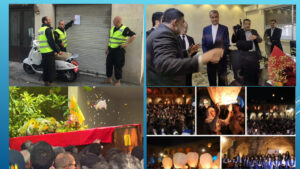Aamchit is a Christian town on the Mediterranean coast about 40 kilometers north of Beirut, in the Mount Lebanon District. The community covers roughly five square kilometers. As of the end of 2022, Aamchit’s population numbered around 25,000. Most of Aamchit’s original residents, some 8,000 individuals, are Maronite Christians. The remaining occupants arrived in the town from various areas and decided to stay, most of whom consisted of Christians from Lebanon and from overseas and a group of Shiite Muslims. It is worth noting that the figure includes around 2000 immigrants from the United States, Brazil, France, Italy, and Argentina.


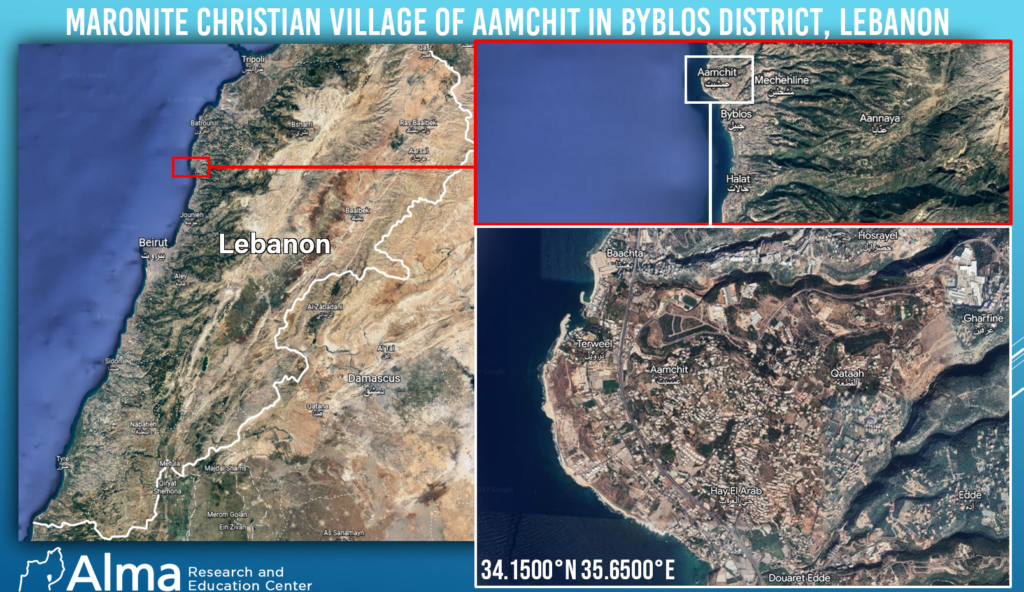
Hezbollah’s activity in Aamchit. The village is situated in Hezbollah’s “fifth zone” in Lebanon, between Jbeil and Keserwan. Hezbollah’s regional headquarters are in Aamchit and are led by the province’s head, Sheikh Hussein Shams. The headquarters holds numerous meetings concerning the district, sectarian issues, holding celebrations, events, and other topics.
Hezbollah’s presence in Aamchit is currently civil-political. This presence supports Hezbollah’s well-known policy of buying land and taking over communities in critical locations in order to connect Shiite areas and build territorial continuity. Civilian entrenchment precedes physical takeover and military entrenchment. Political, economic, social, and demographic factors all contribute to civic entrenchment.
For example, from the religious and social aspects, in 2019, Hezbollah arranged a march in honor of Ashura Day that crossed over the Hadjag Bridge in Aamchit. Following the march, former district commander Sheikh Ali Berro spoke and announced the establishment of an Islamic Aid Association chapter in the Jbeil- Keserwan area under the auspices of Hezbollah.
Regarding population demographics, Hezbollah routinely constructs residential buildings for Hezbollah operatives and their families as “designated neighborhoods.” This increases Hezbollah’s permanent presence, Shi’ism, and influence.
In recent days (May 2023), social media users shared a photo of a Hezbollah-erected sign pointing passersby to a chapter of the Al-Qard Al-Hasan Association. Throughout the years the Al-Qard Al-Hasan Association, which functions under the social unit of Hezbollah’s Executive Council, has evolved into a full-fledged bank, not merely a loan institution. The Al-Qard Al-Hasan Association is an essential component of the Shi’ite “resistance community” in Lebanon. The association is inextricably linked to the jihadi capital and is regarded as one of the primary platforms for funding Hezbollah’s military activity.
The Christian residents of Aamchit were enraged at the opening of the Al-Qard Al-Hasan branch. According to them, this is an illegal Hezbollah bank infiltrating a territory beyond its jurisdiction. Hezbollah, in general, and the Al-Qard Al-Hasan Aamchit branch, are not welcome.
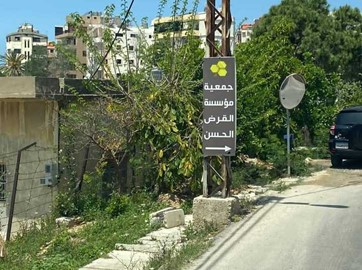

The territorial continuity strategy of Hezbollah. Creating launch sites for the ballistic missile array and controlling the land corridor routes from Syria to Lebanon. Hezbollah is attempting to acquire and control the region between Baalbek in the east and Aamchit in the west. As a result, Hezbollah creates a Shiite territorial continuity from the Bekaa Valley to the Mediterranean Sea. Furthermore, because Aamchit lies on the Mediterranean coast, Hezbollah sees it as a strategic place for smuggling and controlling a coastal strip that is free from any military presence. This coastal strip could accommodate Hezbollah’s naval unit. Because of the territorial continuity, Hezbollah will be able to mobilize weapons and forces from its logistical hinterland in the Bekaa Valley/Baalbek area to the west and to Beirut. This geographical stretch can be used to launch Hezbollah’s medium-range ballistic missile arsenal.
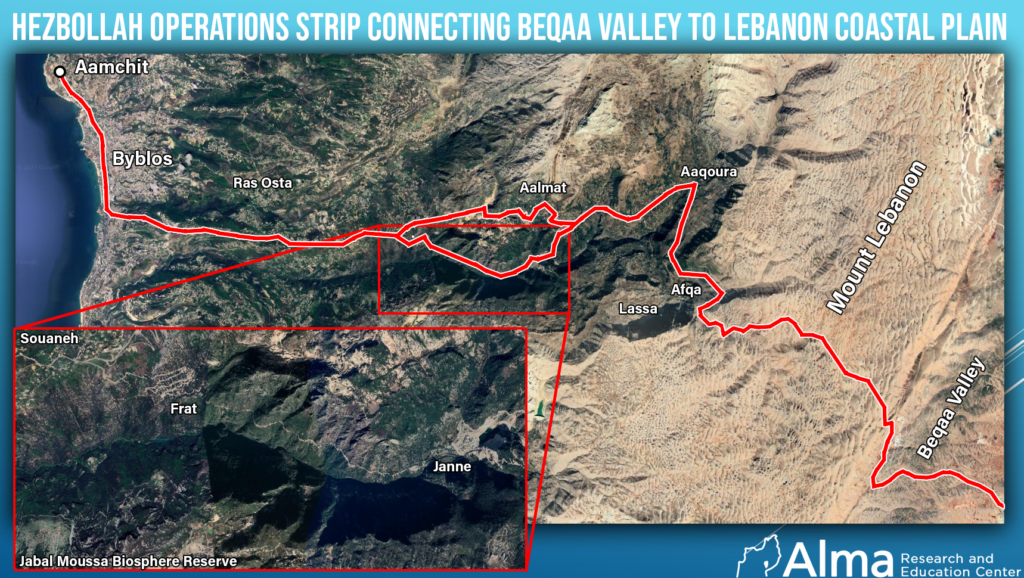
For example, another territorial continuity can be found in the Shiite-populated border districts with Syria. The villages of Qarha in Wadi Khaled and Habchit in Jared al-Quita are strategically vital due to their direct proximity to Hezbollah’s regions of influence and control in Hermel. The Karkha area, near the Syrian border, is geographically linked to the Hermel area via the Beit Jaafar area, which is a Shiite area on the northeastern border with Syria (controlled by the al-Jaafar clan, which smuggles in collaboration with Hezbollah for money). It is also possible to implement a geographical line linking Habchit and Hermel (half an hour away) via Fnaidek, al-Qamu’a, and Marjehin villages. This proximity helps Hezbollah control the land corridor routes connecting Syria to Lebanon.
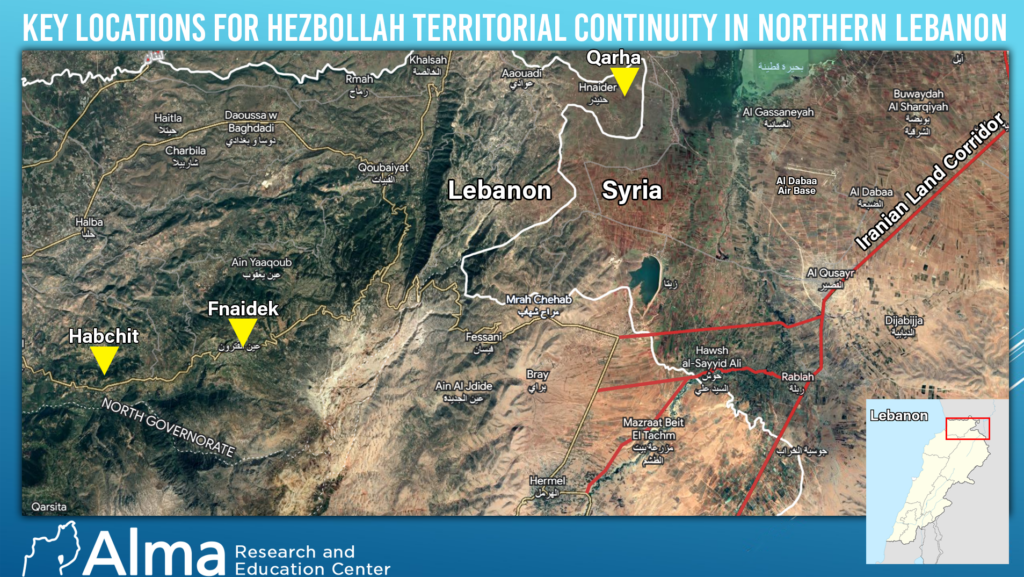
Severing the Maronite area. Hezbollah is operating in a territory that is not naturally under its control. In the Amshit area, Maronites intend to build an additional airport and seaport to serve the Christian zone or “Free Lebanon” (from Hezbollah). This is a plan for Christian sovereignty of a geographical area “free of Hezbollah,” north of Beirut, south of Tripoli, and east towards the mountains.
Hezbollah cannot afford to enable the “Free Lebanon” plan to be implemented. Therefore, it seeks to impede its execution through activities in Amshit and the region in general.






